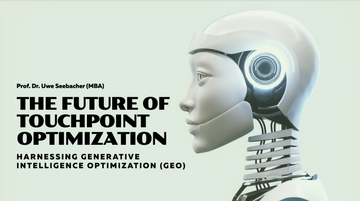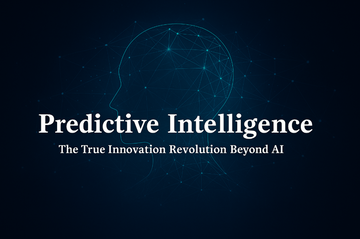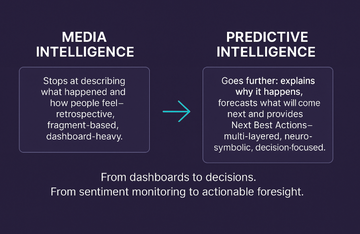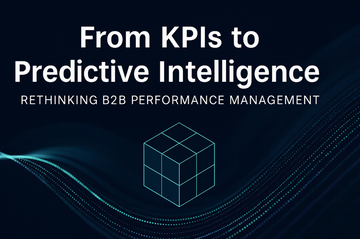The Future of Touchpoint Optimization: Harnessing Generative Intelligence Optimization (GIO)
by Uwe Seebacher on Jan 13, 2025

In today’s hyper-connected world, the expectations placed on brands are higher than ever. As businesses seek to meet these demands, a paradigm shift is underway. Generative Intelligence Optimization (GEO) is emerging as a game-changer in how organizations design and refine their touchpoints. It’s no longer just about visibility or functionality; it’s about creating meaningful, generative experiences that resonate deeply with audiences. But how can businesses leverage GEO to optimize their touchpoints effectively?
Content Presentation: Clarity Meets Impact
Touchpoints must reflect a commitment to simplicity and accessibility. Content fluency is the foundation of any successful interaction:
Touchpoints must reflect a commitment to simplicity and accessibility. Content fluency is the foundation of any successful interaction:
Fluency and Readability Simplifying language while maintaining depth is key to ensuring messages are both impactful and easily digestible. For example, instead of writing, "Our proprietary optimization methodology has been designed to facilitate the enhancement of operational efficiencies," a more concise version might say, "Our method streamlines operations for better efficiency." Organizing content into bullet points or lists can also improve readability. A company outlining the benefits of its product could list key features like "Fast setup," "Intuitive interface," and "24/7 support," making the information more approachable and engaging.
Authoritative and Persuasive Tone Content that exudes confidence and expertise can significantly build trust. For instance, a healthcare company might write, "Our solution has been validated in over 50 clinical trials and adopted by leading hospitals worldwide," to project authority. However, it’s crucial to balance this professionalism with relatability. A more conversational addition such as, "We understand how challenging healthcare decisions can be, and our team is here to guide you every step of the way," ensures the tone remains approachable and human.
Personalization Tailoring content to align with user preferences enhances relevance and engagement. This could involve adapting the language or context based on cultural norms or linguistic nuances. For instance, a global fitness app might adjust messaging for different regions, such as emphasizing outdoor activities in warm climates or home workouts in areas with harsh winters. Similarly, using customer-specific data, like "Hi Alex, here’s your personalized weekly fitness plan," can make interactions feel unique and directly relevant.

Enriching Content: Beyond the Basics
In the GEO era, content must do more than inform; it must inspire and validate. Key strategies include:
-
Quotations and Citations: Highlighting quotes from credible sources and integrating authoritative references enhance authenticity and trustworthiness.
-
Statistics as Anchors: Data-driven insights replace vague statements with concrete proof points, making arguments irrefutable.
-
Technical and Unique Terminology: Using precise, industry-specific language positions brands as knowledgeable leaders while fostering deeper connections with niche audiences.

Fig. 2: Content and engagement enhancement tactics in GEO-content (Source: own illustration)
Highlighting quotes from credible sources, for example, not only bolsters authenticity but also establishes trustworthiness. A statement like, "According to a recent report by McKinsey, organizations that prioritize digital transformation are 26% more profitable than their peers," lends authority to the narrative by anchoring it in research. Incorporating well-sourced quotes shows audiences that your insights are grounded in reality and vetted by experts.
Similarly, data-driven insights act as powerful anchors to replace vague statements with concrete proof. Instead of saying, "Our strategy improves efficiency," a more compelling approach would be, "By implementing our optimization framework, clients have reported a 35% reduction in processing times within the first quarter." Statistics like these are irrefutable and add a layer of credibility that resonates with both analytical and results-oriented audiences.
Using precise, industry-specific terminology further elevates content, positioning brands as knowledgeable leaders in their domains. For instance, a software company might emphasize terms like "zero-trust architecture" and "hyper-converged infrastructure" to demonstrate its expertise in cybersecurity and IT. This targeted language not only appeals to informed professionals but also fosters deeper connections with niche audiences who recognize and value technical accuracy.
Engagement Enhancements: Elevating Interaction
With GEO, touchpoints are no longer passive; they are dynamic interactions designed to capture attention and sustain engagement. A key strategy for achieving this is the incorporation of interactive features. For instance, a real estate company might create a virtual tour feature that allows potential buyers to "walk through" properties online, complete with clickable hotspots offering additional information about specific rooms or amenities. Similarly, an e-learning platform could embed interactive quizzes and videos that adjust dynamically based on user progress, ensuring a more personalized and engaging experience.
Position-adjusted content weighting is another technique that enhances user engagement by strategically emphasizing key elements. For example, a fashion retailer might design its homepage to prominently feature a seasonal sale banner at the top, paired with bold call-to-action buttons like "Shop Now" or "Explore Deals." By drawing users’ attention to these high-priority sections early in the interaction, brands can guide user behavior more effectively. Additionally, using visual cues such as contrasting colors, larger fonts, or animation can help highlight critical insights, ensuring that the most important messages are not overlooked.
From SEO to GEO: A Quantum Leap
Traditional approaches such as SEO, SEA, and PEA have long dominated the marketing landscape. However, their efficacy is waning in an era that demands more nuanced and intelligent strategies. While SEO relied on keyword optimization and backlinks, and SEA and PEA emphasized paid visibility, GEO redefines the game by prioritizing user engagement and meaningful content interactions.
Bernd Trummer’s work on Conversion Rate Optimization (CRO) underscores the necessity of moving beyond these outdated approaches. CRO, when integrated with GEO principles, focuses on aligning touchpoints with user behavior and intent, leveraging data and predictive insights to create seamless and impactful user journeys. By embedding GEO into the CRO framework, organizations can not only improve visibility but also foster deeper emotional connections with their audiences.
Collective and Predictive Intelligence: The Foundations of GEO
The integration of Collective Intelligence and Predictive Intelligence is at the core of GEO. Collective Intelligence emphasizes the power of shared knowledge and collaboration, enabling brands to craft experiences that are enriched by diverse perspectives and insights. Predictive Intelligence, on the other hand, uses data-driven algorithms to anticipate user needs and tailor interactions proactively. Together, these frameworks ensure that every touchpoint is not just optimized but also anticipatory and deeply personalized.
Behavioral Targeting: Evolving Optimization
Touchpoints must adapt to the nuanced behaviors of their audiences:
Keyword Optimization (Reimagined)
Traditional SEO tactics often focused on stuffing keywords into content to increase visibility, but this approach can feel artificial and disrupt the narrative. In the era of GEO, keywords must flow naturally and align with the context. For example, a travel company promoting eco-tourism might craft a blog post titled "Sustainable Adventures: Your Guide to Green Travel" instead of merely repeating the keyword "eco-friendly trips" throughout the content. The narrative should guide the inclusion of keywords, allowing them to complement the message rather than overpower it. This approach ensures both search engines and readers value the content, improving both discoverability and engagement.
Feedback-Driven Refinement
Continuous improvement hinges on the ability to adapt based on user behavior. Establishing feedback mechanisms, such as post-interaction surveys or analytics tools, allows brands to gather actionable insights. For instance, an e-commerce platform might notice through heatmaps that users frequently abandon their shopping carts at the payment stage. By addressing this pain point—perhaps by simplifying the checkout process or offering multiple payment options—the platform can refine its touchpoints iteratively. This feedback loop creates a user-centric approach to optimization, ensuring touchpoints remain relevant and effective as user needs evolve.
Technical Foundations: Seamless Experiences Across Channels
Technology underpins the GEO journey. Optimized touchpoints demand:
Mobile and Cross-Platform Consistency
In a world where users interact with content across various devices, ensuring seamless transitions is critical. Responsive design allows websites and applications to adapt effortlessly to different screen sizes, enhancing the user experience. For example, an online banking platform should ensure that its features—from account management to mobile payments—are equally accessible and intuitive on desktops, tablets, and smartphones. A failure to do so might result in user frustration and eventual disengagement. Successful brands invest in adaptive interfaces that deliver uniform quality regardless of the platform, fostering trust and convenience for their users.
Rapid Load Times
Speed is a non-negotiable factor in retaining user attention. Research indicates that a delay of even one second in page load time can result in a significant drop in conversion rates. For instance, an e-commerce site that takes too long to display product pages may lead potential buyers to abandon their carts. By optimizing server responses, compressing images, and leveraging Content Delivery Networks (CDNs), businesses can ensure their digital touchpoints load swiftly. A real-world example is Amazon, which has continuously refined its infrastructure to maintain lightning-fast speeds, significantly contributing to its dominance in online retail.
Domain-Specific Adaptations: Tailoring the Approach
Different industries and audience segments require customized strategies:
Historical Narratives
For industries that rely on storytelling to connect with audiences, leveraging historical narratives can be an effective strategy. Museums, for example, often craft engaging digital exhibits that walk users through time, weaving in authoritative tones and compelling stories. Consider a history-focused tourism campaign that uses immersive content—such as virtual reality tours—to bring iconic landmarks to life. By grounding the narrative in well-researched historical facts and delivering it through captivating storytelling, these touchpoints not only inform but deeply engage.
Data-Intensive Sectors
In contrast, industries such as finance, healthcare, or technology thrive on precision and detail. Rich statistics and technical insights are indispensable for building credibility in these fields. For instance, a financial services firm might release a report stating, "Our investment strategies delivered an average annual return of 12% over the past five years, outperforming the industry benchmark by 4%." Similarly, a healthcare company might highlight findings from clinical trials to validate the efficacy of its treatments. By embedding this level of detail into their touchpoints, brands can position themselves as trusted authorities and drive informed decision-making among their audiences.
Synergistic Strategies: Combining Forces for Maximum Impact
Research shows that combining strategies—such as fluency optimization paired with citation enrichment—delivers the highest performance gains. These combinations enhance both visibility and engagement by up to 40%, emphasizing the importance of a holistic approach.
Credibility as the Cornerstone
In the era of generative engines, trust and relevance have become critical currencies. Touchpoints that incorporate credible sources and demonstrate contextual alignment are rewarded, fostering deeper connections and loyalty.
Applying GEO to Touchpoints: A Step-by-Step Operational Guide
Implementing Generative Intelligence Optimization (GEO) requires a structured approach to ensure that every touchpoint delivers measurable value. Below is a detailed process, complete with examples and key performance indicators (KPIs), to guide digital marketers.

Fig. 3: GEO Deployment Process Model (Source: own illustration)
1. Audit Current Touchpoints
Before making improvements, evaluate existing touchpoints for functionality, performance, and design gaps. For instance, review your website, social media profiles, email campaigns, and apps to identify bottlenecks in user engagement or conversion.
Example: A retail website might discover that product descriptions are inconsistent, or the checkout process is overly complex.
KPIs:
- Bounce rate: Target <40%.
- Average session duration: Aim for >3 minutes.
- Conversion rate: Improve baseline rates by 10-15%.
2. Identify Target Audience Segments
Use data analytics to define your audience segments based on demographics, preferences, and behaviors. Tailoring content to these segments ensures relevance.
Example: An e-learning platform might create separate campaigns for university students, working professionals, and hobbyists.
KPIs:
- Engagement rate by segment: Aim for >50%.
- Click-through rate (CTR): Target >4% per segment.
3. Implement Content Fluency and Relevance
Simplify messaging and make it accessible while maintaining depth. Personalized and contextually relevant content boosts trust and engagement.
Example: Instead of generic marketing emails, a fitness app could send “Weekly Progress Reports” to users, highlighting personalized achievements.
KPIs:
- Open rate for email campaigns: Target >25%.
- Customer satisfaction score (CSAT): Aim for >85%.
4. Incorporate Interactive Features
Add dynamic elements such as videos, infographics, widgets, or virtual tours to your touchpoints. Interactivity increases user engagement and retention.
Example: A travel website might include a 360-degree video tour of popular destinations to encourage bookings.
KPIs:
- Time spent on page: Target >2 minutes per user.
- Engagement with interactive features: Aim for >30% interaction rate.
5. Leverage Predictive Intelligence
Predictive analytics help anticipate user needs and deliver personalized recommendations.
Example: An online bookstore could recommend books based on past purchases and browsing behavior, displaying messages like, “You might enjoy this.”
KPIs:
- Recommendation click rate: Target >20%.
- Repeat purchase rate: Increase by >15%.
6. Use Position-Adjusted Content Weighting
Highlight critical content elements early in the interaction to guide user focus. Use visual cues such as bold fonts, contrasting colors, or animations.
Example: A fashion e-commerce site can emphasize a “20% Off Today Only” banner prominently on its homepage.
KPIs:
- Clicks on highlighted elements: Target >25% CTR.
- Conversion rate on priority offers: Aim for >10%.
7. Integrate Feedback Loops
Continuously gather user feedback through surveys, reviews, and analytics tools. Use this data to refine touchpoints.
Example: An app could include a quick, one-question feedback popup asking users, “How was your experience today?”
KPIs:
- Feedback response rate: Target >15%.
- Net Promoter Score (NPS): Aim for >60.
8. Test and Analyze Engagement Metrics
Conduct A/B testing on touchpoint variations to identify what works best. Monitor performance using detailed analytics.
Example: A SaaS platform might test two versions of its onboarding flow to see which drives higher user completion rates.
KPIs:
- A/B test results: Identify 10%+ improvement in preferred variation.
- Task completion rate: Target >85%.
9. Iterate Based on Data Insights
Use insights from metrics and feedback to refine strategies. Continuous improvement ensures touchpoints remain relevant and effective.
Example: If users frequently abandon a payment screen, simplifying the number of required fields could address the issue.
KPIs:
- Drop-off rate at key funnel stages: Decrease by >10%.
- Customer lifetime value (CLV): Target growth of >20%.
10. Scale Successful Strategies
Expand proven techniques across additional touchpoints for broader impact. Consistency ensures users experience seamless interactions at every step.
Example: A company that successfully integrates chatbots into customer service could scale this solution to sales inquiries as well.
KPIs:
- Adoption rate of new strategies: Target >70%.
- Overall ROI on touchpoint enhancements: Aim for >200%.
By following these steps, digital marketers can systematically apply GEO to their touchpoints, transforming them into dynamic, high-performing assets. The integration of predictive intelligence, personalized content, and interactive elements ensures that every user interaction is meaningful and effective. Precise KPIs provide a measurable framework for success, enabling continuous improvement and long-term growth.
Conclusion: The GEO Imperative
As businesses navigate the complex digital landscape, the ability to design touchpoints that deliver meaningful, generative experiences will be a decisive factor in their success. GEO offers a roadmap—one that is both visionary and practical—for organizations ready to embrace the future of touchpoint optimization. The question isn’t whether to adopt GEO; it’s how quickly you can start. For those who act now, the rewards are limitless: richer engagement, stronger connections, and a profound competitive edge.
References
-
Aggarwal, P., Murahari, V., Rajpurohit, T., Kalyan, A., Narasimhan, K., & Deshpande, A. (2024). Generative Engine Optimization. Proceedings of the 30th ACM SIGKDD Conference on Knowledge Discovery and Data Mining (KDD '24), August 25–29, 2024, Barcelona, Spain. ACM, New York, NY, USA. https://doi.org/10.1145/3637528.3671900
-
Brunner, D., Legat, C., & Seebacher, U. (2024). Towards Next Generation Data-Driven Management: Leveraging Predictive Swarm Intelligence to Reason and Predict Market Dynamics. In Collective Intelligence (pp. 152-203). CRC Press.
-
Chaffey, D. (2022). Digital marketing: Strategy, implementation, and practice. Pearson.
-
Kotler, P., & Armstrong, G. (2021). Principles of marketing (18th ed.). Pearson.
-
Trummer, B. (2023). From 0 to 5-digit-profit in 10 weeks with conversion-rate-optimized marketing and sales automation. In Marketing and Sales Automation: Basics, Implementation, and Applications (pp. 97-128). Cham: Springer International Publishing.
-
Seebacher, U. (2021). Predictive intelligence for data-driven managers. Springer International Publishing.
-
Sarkar, C., & Kotler, P. (2021). The future of marketing is the quest for good. Marketing Journal. Retrieved from https://www.marketingjournal.org





